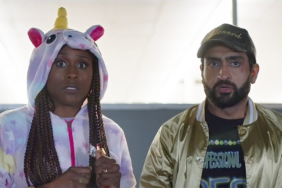As shock and grief over George Michael’s Christmas day death made their way across social media, with the toll of having lost so many music geniuses in a single year apparent in the stricken language used, his importance as an artist and political/cultural figure was repeatedly brought up. His role in bringing coolly unapologetic queerness to the pop sphere, and the way his music was salve for many LGBTQ people even before he officially came out, was noted repeatedly. He was post-Bowie, obviously, and never really part of that extraordinary fraternity of 1980s queer British music artists that included Bronski Beat, the Communards, Culture Club/Boy George, Pete Burns/Dead or Alive, Pet Shop Boys, Erasure, and so many one-hit/no-hit wonders whose work/personas were more explicitly gay. But lots of young (and not so young) queer music fans recognized him as family from the moment he and childhood friend/Wham member Andrew Ridgeley shook their asses in their first music videos.
Part of what makes his death so devastating isn’t just that he died so young, or that his name is added to a distressingly long list of music heavyweights lost this year, but that he now also belongs to that endless roll-call of queer men who died long before their time, their lives being testimony to their talents and the demons they wrestled and occasionally slayed.
Speaking of dying before one’s time and a life that is testament to both a staggering talent and demons wrestled, this video of the duet between George and Whitney Houston (a cover of her hit, “If I Told You That,”) is a deceptively lighthearted multi-volume treatise on artistic genius, identity, self-medication and self-destruction. Their joy in one another’s company and gifts is palpable, and part of that is undoubtedly rooted in mutual recognition of similar backstory.
George Michael isn’t usually listed as one of pop music’s chameleons, one of those artists who shapeshifted persona repeatedly and in the process underscored the permeability of identity, but his transition from gifted teen heartthrob with promise to a master pop craftsman is notable for the leap made. While he did pen modern holiday standard “Last Christmas” at the age of twenty-one, he also wrote the insipid “Wake Me Up Before You Go Go,” a shrewdly calculated bubblegum makeover for his group Wham that made them global superstars.
He proved a savvy reader of the pop market and a genuine artist, all at once. No one could have predicted that the same hands that crafted “Young Guns” would possess the talent to write the delicate, heartbreaking “Jesus to a Child,” written in tribute to his boyfriend Anselmo Feleppa, who died of AIDS. But, of course, by the time that track was released (on his 1996 soul-jazz album Older), Michael had given the world everything from “Careless Whisper” to “Father Figure,” not to mention “Faith,” “Kissing a Fool,” “One More Try,” “I Want Your Sex,” “Freedom 90!” and so many more.
Especially worth noting is the way Michael – one of the premiere blue-eyed soul singers of the 20th century – drew heavily on soul and R&B music as an influence without falling into the grotesque “performance” of Blackness that so many contemporary non-black pop and hip-hop artists now hawk in their bid for relevancy and some one-dimensional notion of authenticity. And for that honest, artful connection to Black music and culture he had a longtime faithful following among Black music fans.
Below are two documentaries on the life and music of George Michael. In the first, the concert documentary I’m Your Man, note the way he takes a scalpel to the gay community and its relationship to closeted versus openly gay artists, laying bare a truth that illuminates conflicting, even hypocritical needs and desires the gay community has when it calls for “role models.” Filmed when he was 43 years old, the documentary captures a thoughtful, smart man who has weathered many legal storms and PR nightmares (which are discussed in the film) and distilled wisdom from them. The 1990 BBC documentary captures him at the peak of his physical beauty, and features a dismissive rock critic misreading and misunderstanding Michael’s talent in such a wrongheaded way that it’s almost laughable. But it’s also ultimately irrelevant, as Michael’s talent speaks for itself.









